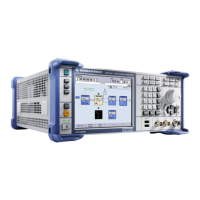Instrument Function
R&S
®
SMBV100A
217Operating Manual 1176.8016.02 ─ 17
"OFF"
Uses the calibrated internal reference frequency.
"ON"
Allows you to apply a deviation to the internal reference frequency,
according to your requirements. To enter the value, use Adjustment
DAC Value.
Remote command:
[:SOURce]:ROSCillator[:INTernal]:ADJust[:STATe] on page 805
Adjustment DAC Value
Sets a user-defined deviation for the internal reference frequency. This value takes
effect when it is activated with Adjustment Active. "0" represents the calibrated state.
The setting range depends on the reference oscillator type and its factory calibration
value.
Note: A factory preset resets this setting to the calibration value of the instrument.
Remote command:
[:SOURce]:ROSCillator[:INTernal]:ADJust:VALue on page 805
5.5.5 Local Oscillator - LO Coupling
The LO Coupling function allows a distribution of the local oscillator signal in way that
multiple RF signals can be driven by the same LO signal. This is mandatory for mini-
mizing the phase drift between these RF signals.
The LO Coupling function is available only for instruments equipped with the option
R&S SMBV-B90 (Phase Coherence).
The R&S SMBV outputs its local oscillator signal at the LO OUT connector (rear of
instrument). In the external local oscillator mode, an external signal must be supplied
at the LO IN connector.
5.5.5.1 Phase Coherence
Phase coherence of two RF signals means that there is a defined and stable phase
relationship between two (or more) RF carriers, i.e. there is a fixed delta phase ΔΦ
between the carriers. Strictly speaking, phase coherence is only defined for CW carri-
ers with the same frequency (or for CW carriers at frequencies that are multiples of
each other).
If two signal generators are coupled via their 10 MHz reference, they are generating
exactly the same frequency but only from the long term perspective. Having a closer
RF Block

